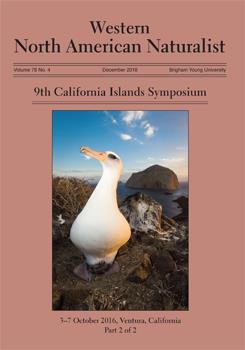The 3 islets of Anacapa Island, with a combined area of 1.1 mi2 (2.9 km2), lie 13 mi (20 km) off the coast of southern California. Historically, each of Anacapa’s islets has been subjected to periodic grazing by sheep, and the eastern islet has also had a sizeable population of introduced rabbits. In spite of these past perturbations, the recovery of the island’s vegetation has been remarkable since sheep removal in 1937. Despite its small size, Anacapa Island supports a surprising diversity of vascular plants, with nearly 200 native taxa from 50 plant families. Twenty-one of these native taxa are restricted to the California Islands; one annual species of Malacothrix occurs as a narrow endemic found only on Middle Anacapa Island, while another annual subspecies of Malacothrix is known only from West and East Anacapa. The floral diversity of this island has apparently been influenced by its close proximity to the mainland and other larger islands and by its diverse topography. Anacapa Island supports a slightly larger native flora than San Miguel Island, which is about 13 times larger and is located about 50 mi (80 km) to the west. The Anacapa native flora is more than twice the size of that found on Santa Barbara Island, which has almost the same area as Anacapa Island but is located approximately 62 mi (100 km) to the southeast. Even though botanical exploration on Anacapa began in 1889, the current work represents the first complete enumeration of the island’s flora.
How to translate text using browser tools
15 February 2018
The Flowering Plants and Ferns of Anacapa Island, California
Steve Junak,
Ralph Philbrick
ACCESS THE FULL ARTICLE





